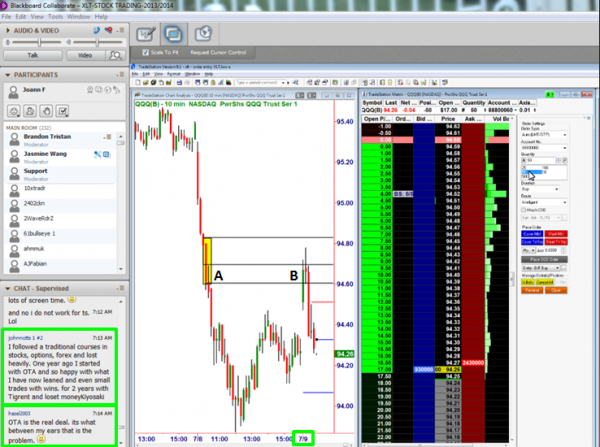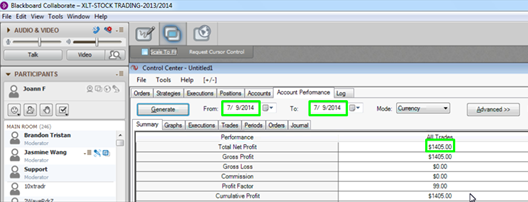![]()
I have been in the trading business for nearly 20 years as a trader, fund manager, and educator, beginning on the floor of the Chicago Mercantile Exchange on the institutional side of the business. If I had to list the top three mistakes I see most traders make, one that would for sure be on the list is when people enter the market. Most traders today still buy and sell “breakouts.” Trading breakouts can be high risk, high stress, low reward, and low probability or this strategy can be low risk, low stress, high reward, and high probability. The difference lies in when you enter into this type of position. I will use a trade we took in the NASDAQ Futures market to illustrate the proper way to enter the position and explain the wrong way to do it.
Before getting into the details of the mistake and correcting it, it’s important to understand two key components of markets.
Why do prices turn and move in any market? Price in any market turns at price levels where demand and supply are out of balance. The consistently profitable trader is able to identify a demand and supply imbalance which means knowing where banks and institutions are buying and selling in a market. By quantifying institution demand and supply areas on a price chart, you can identify market turns and market moves in advance with a very high degree of accuracy.
Who is on the other side of your trade? Trading is simply a transfer of accounts from those who don’t know what they are doing into the accounts of those who do. The consistently profitable trader sells to buyers who pay retail prices in the market and buys from sellers who sell at wholesale prices in the market.
The Mistake
Notice area “A.” Area “A” is the origin of a strong decline in price. Most breakout traders will look to sell short as price breaks out to the downside (A) from the supply level. This type of breakout entry is typically the “sucker bet.” Traders see price moving lower from supply and they give in to emotion and short into that initial decline while price is falling. The problem is that by the time you short the breakout from supply, price has moved so far that it becomes a high risk and low reward trade. Instead, I chose to sit back and let the breakout happen because that breakout tells me that there is a demand and supply imbalance at the origin of that breakout. This is exactly where the significant sellers (banks) are. Next, I wait for price to return to the supply area. When it does at “B,” I am a very interested seller as I am confident I am selling to a novice buyer. I know this because the buyer at “B” is making the two mistakes that every consistent losing (novice) trader makes. First, they are buying after a period of buying and second, they are buying at a price level where supply exceeds demand.
NASDAQ Income Trade: XLT Live Trading Room 7/9/14
Income Trading Profit 7/9/14: $1,400
The Setup
For shorts, many identify a market in a downtrend by using a moving average (I don’t). Next, identify the fresh supply zone and draw two lines around the price action to create a supply zone (yellow shaded area). Make sure the supply level has the pattern that represents where banks and institutions are selling as that is key (Odds Enhancers). Then, make sure there is a significant profit margin (profit target).
The Action
Sell short at “B” when price touches the bottom black line of the level and place your protective buy stop just above the supply level. Adjust your position size so that you are not risking more money than you are willing to lose. This is the proper way to enter the position, not on the initial breakout.
What happens when people enter the market on a breakout is they end up placing their protective stop right where they should be entering in the first place. This can be very frustrating because they stop out for losses often. Yet, they are typically correct on ultimate direction. The proper entry works in any market and any time frame. A key component to making this work which is beyond the scope of this article is this: When taking any buy or sell entries in markets, make sure you know where price is with regard to the larger time frame supply / demand curve. Whether you trade Stocks, Futures, Forex, or Options, understand that behind all the candles on your screen in all these markets are people and their emotions. Most will fall for the emotional breakout trading traps while others will get paid from them. In short, instead of entering the market on the initial move higher or lower from a level, enter on the first pullback into the fresh supply or demand level. This is one of the most common mistakes I see traders make and a very easy one to correct.
Hope this was helpful. Have a great day.
Note: All information on this page is subject to change. The use of this website constitutes acceptance of our user agreement. Please read our privacy policy and legal disclaimer. Opinions expressed at FXstreet.com are those of the individual authors and do not necessarily represent the opinion of FXstreet.com or its management. Risk Disclosure: Trading foreign exchange on margin carries a high level of risk, and may not be suitable for all investors. The high degree of leverage can work against you as well as for you. Before deciding to invest in foreign exchange you should carefully consider your investment objectives, level of experience, and risk appetite. The possibility exists that you could sustain a loss of some or all of your initial investment and therefore you should not invest money that you cannot afford to lose. You should be aware of all the risks associated with foreign exchange trading, and seek advice from an independent financial advisor if you have any doubts.
Editors’ Picks
EUR/USD holds gains above 1.0700, as key US data loom

EUR/USD holds gains above 1.0700 in the European session on Thursday. Renewed US Dollar weakness offsets the risk-off market environment, supporting the pair ahead of the key US GDP and PCE inflation data.
GBP/USD extends recovery above 1.2500, awaits US GDP data

GBP/USD is catching a fresh bid wave, rising above 1.2500 in European trading on Thursday. The US Dollar resumes its corrective downside, as traders resort to repositioning ahead of the high-impact US advance GDP data for the first quarter.
Gold price edges higher amid weaker USD and softer risk tone, focus remains on US GDP

Gold price (XAU/USD) attracts some dip-buying in the vicinity of the $2,300 mark on Thursday and for now, seems to have snapped a three-day losing streak, though the upside potential seems limited.
XRP extends its decline, crypto experts comment on Ripple stablecoin and benefits for XRP Ledger

Ripple extends decline to $0.52 on Thursday, wipes out weekly gains. Crypto expert asks Ripple CTO how the stablecoin will benefit the XRP Ledger and native token XRP.
US Q1 GDP Preview: Economic growth set to remain firm in, albeit easing from Q4

The United States Gross Domestic Product (GDP) is seen expanding at an annualized rate of 2.5% in Q1. The current resilience of the US economy bolsters the case for a soft landing.
RECOMMENDED LESSONS
Making money in forex is easy if you know how the bankers trade!
Discover how to make money in forex is easy if you know how the bankers trade!
5 Forex News Events You Need To Know
In the fast moving world of currency markets, it is extremely important for new traders to know the list of important forex news...
Top 10 Chart Patterns Every Trader Should Know
Chart patterns are one of the most effective trading tools for a trader. They are pure price-action, and form on the basis of underlying buying and...
7 Ways to Avoid Forex Scams
The forex industry is recently seeing more and more scams. Here are 7 ways to avoid losing your money in such scams: Forex scams are becoming frequent. Michael Greenberg reports on luxurious expenses, including a submarine bought from the money taken from forex traders. Here’s another report of a forex fraud. So, how can we avoid falling in such forex scams?
What Are the 10 Fatal Mistakes Traders Make
Trading is exciting. Trading is hard. Trading is extremely hard. Some say that it takes more than 10,000 hours to master. Others believe that trading is the way to quick riches. They might be both wrong. What is important to know that no matter how experienced you are, mistakes will be part of the trading process.


